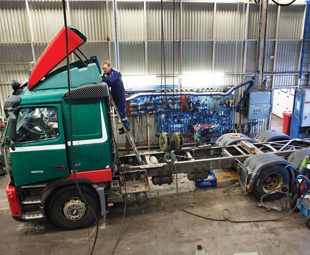Vehicle recycling: long way to go

When it comes to recycling cars and commercial vehicles, South Africa has a lot to learn from first world countries where OEMs themselves set the pace. UDO RYPSTRA asks whether the time has not come for their greater involvement in the local market for second-hand parts and the recycling of hazardous fluids, as well as of end-of-life vehicle skeletons.
How much of the brand new truck you have just bought is made of recycled materials? And what can you get for it when it has done more than one million kilometres with the best parts to be sold on the used vehicle market and the rest as scrap?
While both the used vehicle parts and scrap metal market in South Africa are highly developed, they are not as sophisticated and regulated as in Europe and America where OEMs themselves have sophisticated production systems in place to embrace the recycling of old cars, vans, trucks and buses; whereby old becomes new in a sustainable process that benefits both the economy and ecology.
In South Africa, scrapyards have become a haven for those seeking much cheaper spare parts than the new ones bought at OEM and other dealerships. But they are also fast becoming a massive eyesore in industrial townships and along our national roads where the metal carcasses, stripped of their intestines and heaped on top of one another, compete with rural shanty towns to turn the landscape into a scene of desolation and destruction – like a scene in one of those Mad Max movies.
You won’t see this in Europe or the United Kingdom where, every year, motor vehicles which have reached the end of their useful lives create up to nine million tons of waste. There, OEMs take back “end-of-life” vehicles up to 3 500 kg in gross vehicle mass (GVM) in accordance with EU-Directive 2000/53/EG OEMs from the very last end-user (last vehicle holder) free of charge provided it is a passenger vehicle with a maximum of nine seats or a van or light truck with a maximum weight of 3 500 ton GVM.
In addition, to qualify for a free take-back, all significant components such as the engine, gearbox, chassis, body work, catalytic converter or electronic control unit have to be present in the vehicle. It also must be, or have been, registered in a member state of the European Union for a minimum of one month and be submitted together with the vehicle registration documents.
OEMs are now doing it with trucks over 3 500 kg GVM on a voluntary basis as well.
Volvo Trucks says it works hard to reduce the company’s environmental footprint, and has applied a carefully thought-out recycling strategy since the mid-1990s. “We have to consider the environment, our resources and future generations,” said Volvo Trucks’ environmental affairs director, Lars Mårtensson, in a corporate statement issued last month.
At the Volvo Truck Centre just outside Göteborg, for example, old trucks are dismantled down to their last nuts and bolts and their materials recycled after hazardous fluids like refrigerants, brake fluid and oil have been carefully drained off for recycling.
All components and materials removed from the truck that cannot be sold on the used parts market will be put into containers marked separately for iron, aluminium, brass, copper, plastic, combustibles and so on. All parts that are too worn out will be sent away for melting or incineration, to be reused in the form of new products. Nothing goes to landfill.
“There are sound financial reasons for the customer to recycle the truck. We try to aid that process as much as possible, for instance by providing detailed instructions with each truck on how it is to be recycled,” says Mårtensson. “Since it takes less energy to manufacture products from recycled material than from new raw materials, the environmental gains are considerable,” he continues. “Moreover, recycling also has financial advantages. If, for instance, there is a shortage of certain metals and prices rise, recycling becomes even more important. At present, just over 90% of a scrapped Volvo truck is recycled. When a Volvo FH is scrapped, more than nine tons of various materials are recovered for recycling.”
Volvo Trucks has what it calls an Environmental Product Declaration calculator (what next?). It says a recycled truck reduces carbon dioxide emissions by just over four tons. This is because of the reduced energy required to manufacture new products from recycled materials than from new raw materials. And that if a Euro 3 truck were replaced by a Euro 5 truck that consumes almost 8% less fuel, particulate emissions would also be cut by 80%. And the more modern truck would also release 86 tons less carbon dioxide during its lifetime than its older counterpart, says Mårtensson.
The Daimler Group is just as committed to the EU directive, which it has supported since 2002 and expanded on by taking back all end-of-life vehicles since 2007.
The Mercedes-Benz Used Parts Center in Europe makes a key contribution to recycling through its resale of tested and certified used components and also provides end-users with detailed disassembly information via the electronic International Dismantling Information Technology System (IDIS).
It has established networks for taking back end-of-life vehicles in all EU countries in co-operation with local importers and disposal companies. In 2009, it collected a total of
31 064 tons of end-of-life parts and materials for recycling. Some 1,1 million litres of coolant and 807 000 litres of brake fluid were also recycled.
Apart from adhering to the directive’s set of clear quantified targets for reuse, recycling and recovery of vehicles and components, it also follows the directive to manufacture new vehicles which are easy to recycle.
Says Mårtensson: “Every Volvo truck is designed and built at the factory to take account of what will happen on the day the truck is withdrawn from service. We tailor the technology needed for subsequent dismantling and recycling into the design and production of new trucks. For example, we use plastic rather than metal clips to attach wires and hoses, since metal clips take far longer to remove.”
The materials used are also carefully selected.
“The challenge is to balance usage demands against recycling properties. For some purposes, plastics that can be melted down are more suitable than plastics that are incinerated, while for other purposes the opposite applies.” explains Mårtensson.
Mercedes-Benz applies the same principle:
“As early as the development stage, a high priority is placed on incorporating environmental protection and recycling capability aspects into our vehicle designs. One example involves the use of single-origin materials for bumpers and underbody panelling, which simplifies the dismantling of such components and ensures high-quality recycling,” it says in a corporate statement.
The sad part is that South Africa has not yet implemented the EU directive or a similar take-back system; it is still left to the scrapyards to take back vehicles for their used parts and the recycling of components and materials. Prices paid vary depending on the condition of the vehicle and are therefore negotiable.
With many insurance companies now implementing the second-hand spares approach, the second-hand parts market has become a multi-billion rand industry. Choosing this option for vehicle repairs is not only a way to save money, it also benefits the environment. The auto recyclers around the country have invested millions in equipment, training and computers to comply with stricter environmental laws. Industry statistics show that since 1997 enough steel has been recovered from recycled trucks and cars to build 13 million new ones.
In addition, the country has a well-established recycling industry consisting of various recycling streams such as for metal, glass, plastic, paper and other materials.
In the metal sector, they comprise major recyclers such as the New Reclamation Group (NRG), Power Metal Recyclers, SA Metals & Machinery Company and National Scrap Metal, represented over the years by associations such as the National Recyclers Organisation (NRO) and the Metal Recyclers Association (MRS).
While many of them operate their own trucking fleets for waste collection, it has also seen the establishment of many small business entrepreneurs who specialise in this kind of transportation.
Having been able to recycle various types of scrap metals, recyclers have been able to save the country billions of rands in the production of metal chips, briquets and other items, for the domestic market, from an environmental as well as a lower metal cost point of view. It has also led to job creation.
However, recyclers have also been accused, especially by the secondary aluminium industry, of exporting the chips at more lucrative prices and, in the process, creating local shortages of scrap and so put many secondary aluminium companies out of business. This, and the implementation of the Industrial Policy Action Plan (IPAP) has led to the Department of Trade now considering measures to limit the exportation of scrap metal to allow for increased beneficiating in South Africa.
The DTI argues that scrap metal is an important input source for downstream manufacturing, such as for white appliances, vehicle components, tools and other items, and that adequate supply could help to reduce costs. It has stressed that government was not aiming to completely stop the exportation of scrap metal, but that it was seeking to ensure that only surplus scrap was exported.
IPAP makes provision for the establishment and definition of minimum levels of beneficiation for 10 commodities and to lay the foundation for building beneficiation value chains.
Details of the plan and a decision on scrap export tariffs are expected to be announced soon.
Meanwhile, with South Africa hosting the next international Copenhagen-like Climate Change conference in Durban later this year, the question arises: Should South Africa not also implement the EU directive to clear up the (s)crap lying in our backyards? We won’t be able to clean up the mess in time for the summit, but OEMs operating in this country could certainly show us the way to go.
Published by
Focus on Transport
focusmagsa




